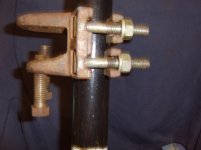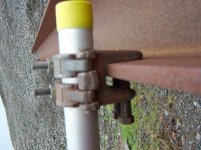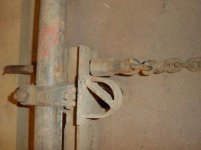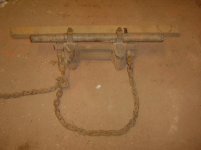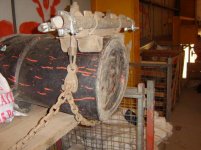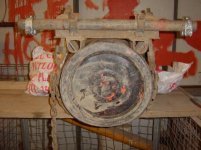You are using an out of date browser. It may not display this or other websites correctly.
You should upgrade or use an alternative browser.
You should upgrade or use an alternative browser.
whats the best "double" you have worked with and why
- Thread starter K1ng B1lly
- Start date
Ken Cain
Active member
Mills 90 and the Aberdeen Transoms
Like you Garry I’m also a great believer in Mills 90 couplings,
I remember the Mills 90s quite well. When tightened to 48 Nm they had a unique gripping action enabling them to carry a load of more than twice the SWL of a drop forged or pressed steel coupling.
When installed correctly the Mills 90 behave more like a shackle by biting into the steel tube as they start taking the load, as opposed to friction clamp type fittings such as the drop forged or pressed steel type, this unique feature of the Mills coupling eliminates any slipping and gives it greater strength. The safe working load of a drop forged or pressed steel double coupling to EN74 Class A is 6.1 kN Whereas a Mills 90 installed under engineering conditions has a safe working load of 12.5 kN.
Even under extreme loading the Mills double will not slip although loads in excess of 4 tonnes have been known to cause shearing of the bolt seating. Another good thing about the Mills 90 is that due to its unique action under load there was never any need to install a check coupling.
However customers would sometimes specify the use of check couplings, and if a check is fitted a clearance of not less than 5 mm between the check and the fitting under load must be left.
The 5 mm gap enables the loaded coupler to rotate slightly as it takes up the load. If that is prevented then the Mills 90 will slip at loads lower than the specified safe working load.
As the Mills 90 needs to rotate to take up its maximum load it can never be used as a supplementary coupler, nor can the load capacity be increased by any other coupler acting as a supplementary to it.
During manufacture the Mills 90 is heat treated to give it a characteristic spring steel property.
When using Mills 90 fittings there is no need to fit an Aberdeen Transom and this is because the main transom can be bearing onto the Ledger but clamped onto the standard with a Mills 90 without clashing with any other coupling.
So why aren’t the Mills 90 still being used? Well one reason is that they are not manufactured to BS EN 12811-1:2003 which tells us that scaffold fittings should comply to BS EN 74-1.
Like you Garry I’m also a great believer in Mills 90 couplings,
I remember the Mills 90s quite well. When tightened to 48 Nm they had a unique gripping action enabling them to carry a load of more than twice the SWL of a drop forged or pressed steel coupling.
When installed correctly the Mills 90 behave more like a shackle by biting into the steel tube as they start taking the load, as opposed to friction clamp type fittings such as the drop forged or pressed steel type, this unique feature of the Mills coupling eliminates any slipping and gives it greater strength. The safe working load of a drop forged or pressed steel double coupling to EN74 Class A is 6.1 kN Whereas a Mills 90 installed under engineering conditions has a safe working load of 12.5 kN.
Even under extreme loading the Mills double will not slip although loads in excess of 4 tonnes have been known to cause shearing of the bolt seating. Another good thing about the Mills 90 is that due to its unique action under load there was never any need to install a check coupling.
However customers would sometimes specify the use of check couplings, and if a check is fitted a clearance of not less than 5 mm between the check and the fitting under load must be left.
The 5 mm gap enables the loaded coupler to rotate slightly as it takes up the load. If that is prevented then the Mills 90 will slip at loads lower than the specified safe working load.
As the Mills 90 needs to rotate to take up its maximum load it can never be used as a supplementary coupler, nor can the load capacity be increased by any other coupler acting as a supplementary to it.
During manufacture the Mills 90 is heat treated to give it a characteristic spring steel property.
When using Mills 90 fittings there is no need to fit an Aberdeen Transom and this is because the main transom can be bearing onto the Ledger but clamped onto the standard with a Mills 90 without clashing with any other coupling.
So why aren’t the Mills 90 still being used? Well one reason is that they are not manufactured to BS EN 12811-1:2003 which tells us that scaffold fittings should comply to BS EN 74-1.
borospanner
Well-known member
- Joined
- Jan 24, 2011
- Messages
- 319
- Reaction score
- 0
Double Maxim !
Thanks for that information Ken. Years back I used the Mills 90 and always considerd it a great fitting particularly on hangers.I remember using the old half inch also. I remember doing hangers, double on double, no need for checks but as you pointed out, you would often be pulled up on site for not having checks. It was a waste of time arguing the case that they were not needed.
cgee1968
Member
mills double what i used many a good year ago ,then presco ,boulton nxt,then sticky
Garry Adams
Well-known member
Ken
Great post and good Technical Information for both the uninitiated Scaff and Design Engineer.
The only thing left to do is for me to try and expand on two of your observations.
1. a Mills 90 installed under Engineering conditions: are we talking about optimal Limits, Reliability, Integrity and Stability of the Structure and dare I say it the compliance of B.S. 1139 Torque Values ?.
2. Why aren't the Mills 90 still used: With the demise of the British Manufacturing Base, there is a large influx of Asian and Chinese Imports, these cheap and cheerful components that in my view are very low Quality Control, badly finished and ill fitting when presented to the Tube, have taken the place of the more expensive Quality component, in my view this is a false economy which gives rise to several H&S issues. Thoughts please.
Perhaps a section ( in the TG Docs ) on component part type selection/options would benefit Scaffolding Practitioners ?
Garry...
Great post and good Technical Information for both the uninitiated Scaff and Design Engineer.
The only thing left to do is for me to try and expand on two of your observations.
1. a Mills 90 installed under Engineering conditions: are we talking about optimal Limits, Reliability, Integrity and Stability of the Structure and dare I say it the compliance of B.S. 1139 Torque Values ?.
2. Why aren't the Mills 90 still used: With the demise of the British Manufacturing Base, there is a large influx of Asian and Chinese Imports, these cheap and cheerful components that in my view are very low Quality Control, badly finished and ill fitting when presented to the Tube, have taken the place of the more expensive Quality component, in my view this is a false economy which gives rise to several H&S issues. Thoughts please.
Perhaps a section ( in the TG Docs ) on component part type selection/options would benefit Scaffolding Practitioners ?
Garry...
Ken Cain
Active member
Hi Scaffy,
The Mills 90’s have not been banned and are still in use, the problem is they never conformed with BS1139-2.1 Couplers (superseded) or BS EN 74, that’s why some designers and health and safety departments have discouraged their use on site.
(BS 1139 was first published in November 1943).
Some customers are quite fussy and insist that the scaffolding complies with the British Standards and of course this is backed up by TG20:08 Clause 4.1 (page 18) “All access scaffolds should be designed in accordance with the requirements of BS EN 12811-1:2003.
We all know that the Mills 90 has a safe working load of 12,5 kN (under engineering conditions) Engineering conditions means that the fittings and tubes have to be in good condition and be installed by a competent person, that’s someone who understands the workings of the Mills type couplings.
The Mills 90’s have not been banned and are still in use, the problem is they never conformed with BS1139-2.1 Couplers (superseded) or BS EN 74, that’s why some designers and health and safety departments have discouraged their use on site.
(BS 1139 was first published in November 1943).
Some customers are quite fussy and insist that the scaffolding complies with the British Standards and of course this is backed up by TG20:08 Clause 4.1 (page 18) “All access scaffolds should be designed in accordance with the requirements of BS EN 12811-1:2003.
We all know that the Mills 90 has a safe working load of 12,5 kN (under engineering conditions) Engineering conditions means that the fittings and tubes have to be in good condition and be installed by a competent person, that’s someone who understands the workings of the Mills type couplings.
Ken Cain
Active member
The Gravelock Versus the SK (Stephen Knight)
The Gravelock Versus the SK (Stephen Knight)
It’s true there are several types of girder clamp on the market. The first clamp I ever used back in the sixties was an SK, I remember being told that the SK stood for Stephen Knight, he was the guy who invented it and although it never caused me any problems I did hear stories about the SK’s causing collapse due to the thread being stripped and causing the scaffold to drop.
Should any shock loading occur to the SK it’s possible that it may strip the thread causing the scaffold to fall. The Gravelock is made in a completely different way, it’s made as one single unit, so if it was subject to a shock loading which stripped the thread the fitting would only fall 40mm or so. This is because the shoulder of the Gravelock would come to a rest on the flanges of the steel beam and move no further so in my mind I would only recommend the Gravelock as the more suitable fitting.
At one time the RSJ girder clamp was quite popular.
The minimum tightening torque for Gravelock and RSJ = 54Nm.
The Gravelock Versus the SK (Stephen Knight)
It’s true there are several types of girder clamp on the market. The first clamp I ever used back in the sixties was an SK, I remember being told that the SK stood for Stephen Knight, he was the guy who invented it and although it never caused me any problems I did hear stories about the SK’s causing collapse due to the thread being stripped and causing the scaffold to drop.
Should any shock loading occur to the SK it’s possible that it may strip the thread causing the scaffold to fall. The Gravelock is made in a completely different way, it’s made as one single unit, so if it was subject to a shock loading which stripped the thread the fitting would only fall 40mm or so. This is because the shoulder of the Gravelock would come to a rest on the flanges of the steel beam and move no further so in my mind I would only recommend the Gravelock as the more suitable fitting.
At one time the RSJ girder clamp was quite popular.
The minimum tightening torque for Gravelock and RSJ = 54Nm.
scaffy
Well-known member
- Joined
- Nov 28, 2009
- Messages
- 6,666
- Reaction score
- 0
interesting post ken , learn something new every day , i have never used the original SK however Garry Adams did email me some pics last year so i am familiar with the product
So are DH couplers illegal now and what about Mills singles (g clamps)
So are DH couplers illegal now and what about Mills singles (g clamps)
simian
Well-known member
- Joined
- Dec 6, 2010
- Messages
- 634
- Reaction score
- 0
Hi Scaffy,
The Mills 90’s have not been banned and are still in use, the problem is they never conformed with BS1139-2.1 Couplers (superseded) or BS EN 74, that’s why some designers and health and safety departments have discouraged their use on site.
(BS 1139 was first published in November 1943).
Some customers are quite fussy and insist that the scaffolding complies with the British Standards and of course this is backed up by TG20:08 Clause 4.1 (page 18) “All access scaffolds should be designed in accordance with the requirements of BS EN 12811-1:2003.
We all know that the Mills 90 has a safe working load of 12,5 kN (under engineering conditions) Engineering conditions means that the fittings and tubes have to be in good condition and be installed by a competent person, that’s someone who understands the workings of the Mills type couplings.
We have inspected and audited numerous Interserve sites and they still use their 90's, putlog clips and swivels today. As said above a drop forged class B double is around 90p hence the reason mills 90's are in decline.
Garry Adams
Well-known member
Ken
yet another thought provoking post, shock load on threads is concern and one to be designed out---I usualy ask the Scaffs to position Tubes on the inside if the wed of the steel rather than the suffit of the steel, if the butt tube is positioned on the underside if the steel the threads are taking all the load.
what is your view on the underdeck 2000
yet another thought provoking post, shock load on threads is concern and one to be designed out---I usualy ask the Scaffs to position Tubes on the inside if the wed of the steel rather than the suffit of the steel, if the butt tube is positioned on the underside if the steel the threads are taking all the load.
what is your view on the underdeck 2000
Attachments
Garry Adams
Well-known member
Scaffy
aye, I was never a big fan of then either---only good point is that the threads in the jaws of then fitting do not come under downward stress---a heavy peice of kit :sad:...
aye, I was never a big fan of then either---only good point is that the threads in the jaws of then fitting do not come under downward stress---a heavy peice of kit :sad:...
scaffy
Well-known member
- Joined
- Nov 28, 2009
- Messages
- 6,666
- Reaction score
- 0
20 years in the game dude and i aint ever come across one yet and we have some weird and wonderfull fittings
yeh did u send me a pic of that underdeck fitting??
Like the look of them GKN pipe clamps with the chains , i see on scaffold supplies website he is now making them
The friction clamps we supply are the only ones available which are manufactured to the original GKN drawings, by our associate engineering company who are I.S.O. 9001:2008 approved. The body of the friction clamp is inspected by an independent testing house, the scaffolding components are manufactured by Presco UK and the High Tensile Chain is certified and marked accordingly. Copies of test certificates are available on request.
Friction Clamps at Scaffolding Supplies
yeh did u send me a pic of that underdeck fitting??
Like the look of them GKN pipe clamps with the chains , i see on scaffold supplies website he is now making them
The friction clamps we supply are the only ones available which are manufactured to the original GKN drawings, by our associate engineering company who are I.S.O. 9001:2008 approved. The body of the friction clamp is inspected by an independent testing house, the scaffolding components are manufactured by Presco UK and the High Tensile Chain is certified and marked accordingly. Copies of test certificates are available on request.
Friction Clamps at Scaffolding Supplies
Last edited:
Ken Cain
Active member
The DH Coupler and the Mills singles
Thanks for your reply Scaffy,
The DH Coupler and the Mills singles are still in use today.
The problem with the DH which is used to join two tubes at right angles is it’s safe working load which is only 1.25kN and it’s likelihood of causing indents in the tube of more than 1.5 mm when tightened.
The Mills Single, known as a Mills Putlog Coupler, when installed correctly has a safe working load of 3.0kN, which is impressive, against the Safe Working Load of a Cold Pressed or Drop Forged Putlog Coupler which both have a safe working load of 0.63kN.
The following clause from BS 1139 - 2.1 (Superseded by BS EN 74) clause: 5.2.1.5 Neither the wedge nor the end of the bolt should directly touch the tube in order to tighten the fitting unless the contact of wedge or bolt along the tube is greater than 18 mm in all cases. If necessary a permanently attached spacer shall be incorporated to protect the tube.
5.2.1.6 A coupler which is secured by means of a screw shall be so constructed that it will perform satisfactorily when tightened as follows:
Tightening torque shall be indicated by the manufacturer and preferably shall be between 40 and 80 Nm. For types of couplers where hexagonal nuts are used with ISO threads, the following tightening torques are preferred:
a) width across flats 22 mm: 50 Nm
b) width across flats 24 mm: 80 Nm.
Due to the method of tightening the DH fittings involves screwing the bolt into the tube with a podger it fails to comply with the BS EN 74 as follows: 6.2.6 A coupler shall not cause an indentation greater 1.5mm.
The DH and the Mills single are not illegal, although the DH fails on its test of strength and its ability to deform the tube. On the other hand the Mills Single is an excellent coupler due to its load bearing properties.
I hope this information has been of some help.
Thanks for your reply Scaffy,
The DH Coupler and the Mills singles are still in use today.
The problem with the DH which is used to join two tubes at right angles is it’s safe working load which is only 1.25kN and it’s likelihood of causing indents in the tube of more than 1.5 mm when tightened.
The Mills Single, known as a Mills Putlog Coupler, when installed correctly has a safe working load of 3.0kN, which is impressive, against the Safe Working Load of a Cold Pressed or Drop Forged Putlog Coupler which both have a safe working load of 0.63kN.
The following clause from BS 1139 - 2.1 (Superseded by BS EN 74) clause: 5.2.1.5 Neither the wedge nor the end of the bolt should directly touch the tube in order to tighten the fitting unless the contact of wedge or bolt along the tube is greater than 18 mm in all cases. If necessary a permanently attached spacer shall be incorporated to protect the tube.
5.2.1.6 A coupler which is secured by means of a screw shall be so constructed that it will perform satisfactorily when tightened as follows:
Tightening torque shall be indicated by the manufacturer and preferably shall be between 40 and 80 Nm. For types of couplers where hexagonal nuts are used with ISO threads, the following tightening torques are preferred:
a) width across flats 22 mm: 50 Nm
b) width across flats 24 mm: 80 Nm.
Due to the method of tightening the DH fittings involves screwing the bolt into the tube with a podger it fails to comply with the BS EN 74 as follows: 6.2.6 A coupler shall not cause an indentation greater 1.5mm.
The DH and the Mills single are not illegal, although the DH fails on its test of strength and its ability to deform the tube. On the other hand the Mills Single is an excellent coupler due to its load bearing properties.
I hope this information has been of some help.
Garry Adams
Well-known member
Scaffy
I found 3 of these friction clamps in a Debiz Yard in Aberdeen, they were back loaded from Offshore ( see pic below ) ye, the UK friction Clamp Suppler contacted me for a wee chin way regarding aquasitions of said FC's---also, a Member John Yang of China offered to make the Friction Clamps, however, knowing the track record of Chinese Imports I declined.
I't good to know that there is a Manufacturing Base for these Friction Clamps, they are still alive and kicking all be it used on sSecialist Structures.
I found 3 of these friction clamps in a Debiz Yard in Aberdeen, they were back loaded from Offshore ( see pic below ) ye, the UK friction Clamp Suppler contacted me for a wee chin way regarding aquasitions of said FC's---also, a Member John Yang of China offered to make the Friction Clamps, however, knowing the track record of Chinese Imports I declined.
I't good to know that there is a Manufacturing Base for these Friction Clamps, they are still alive and kicking all be it used on sSecialist Structures.
